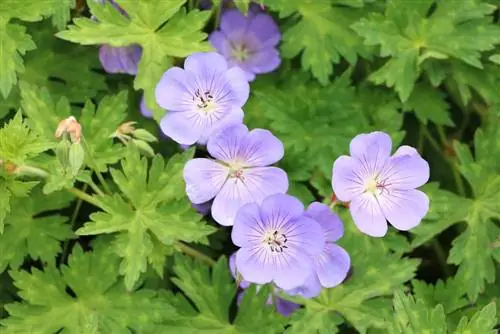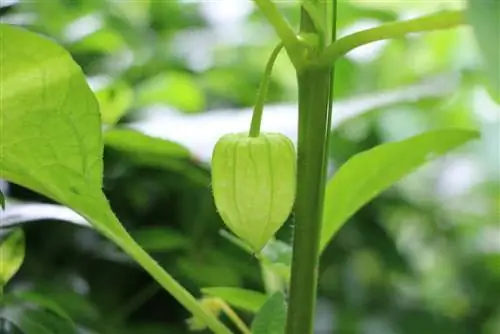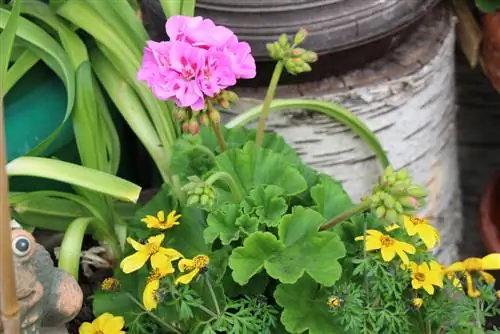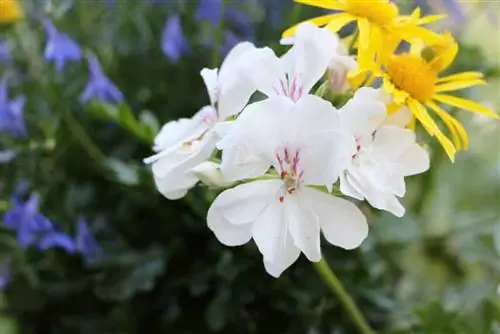- Author admin [email protected].
- Public 2023-12-17 03:39.
- Last modified 2025-01-24 12:45.
Geraniums can normally stay in the box until late autumn until they are prepared for winter storage. If frost is forecast or the temperatures are close to freezing, you should move your geraniums to a safe place at the latest. The plants can survive a day or two of light frost, but it's not good for them, even if they still look fresh. It's better to be on the safe side and move the plants to their winter quarters a few days early rather than take a risk. When the flowers have almost faded and the leaves are changing color and starting to fall off, it is time to store geraniums. In late autumn, the geraniums should no longer be kept moist, otherwise the roots and branches run the risk of rotting.
Overwintering geraniums is not complicated and requires very little space. There are many different methods of overwintering geraniums that you can choose depending on the space available.
- In the plastic bag, hanging upside down
- In clay pots
- As a whole in the flower box
- Root naked in newspaper
- In the hole
The pruning
Before you store geraniums for overwintering, they must be prepared accordingly. In late autumn, around mid-October, the first thing you need to do is remove all shoot tips with buds, young, new leaves and flowers with sharp secateurs. It is sufficient if two to three nodes remain per shoot. Then carefully remove all leaves and also shorten the stems, as they are susceptible to diseases and pest infestation. Dead parts should also be removed. If the geraniums are bare, they can be carefully removed from the flower box. Separate each plant and remove excess soil. Make sure that the fine roots are just covered and that a high proportion of fine roots is retained. However, it is not necessary to overwinter a lot of soil.
It is important to remove all existing flowers, buds and leaves when pruning, as they need water and otherwise the soil and thus the roots would dry out. In the worst case, it can even lead to pest infestation or disease in the plants. If necessary, you can also take cuttings from the cut shoots.
Preparation for storage
Wintering in a plastic bag is a method that many hobby gardeners use. The root ball of the plants prepared for winter is wrapped in a bag to prevent moisture loss. A little air can reach the roots, but they must not dry out. Finally, the geraniums are hung upside down.
In the second method, the geranium is overwintered in clay pots. After pruning and removing the soil, the geraniums can be placed in pots in groups of three or four. The roots can then be covered with a mixture of sand and potting soil.
You can also overwinter the plants bare-rooted. To do this, wrap the winter-ready plants in several layers of newspaper when they are dry and bundle the plants together.
Another space-saving method is to overwinter the geraniums in a hole in the ground. Of course, this is only possible if you have your own garden. However, outside temperatures must not fall below -2 degrees Celsius. To do this, dig a hole approx. 80 centimeters deep and fill it with twigs, brushwood or straw. Now place the trimmed geraniums, free of soil and leaves, into this hole and then fill it with the excavated soil. To provide additional protection, you can cover the hole with a straw mat at the end.

The plants can also overwinter as a whole in the flower box. With this method, the plants are also cut back but not removed from the soil. However, this takes up more space and you should usually replace the soil in the boxes the following year.
No matter which method you choose, it is advisable to cut the plants back by about a third or half. For overwintering they should have a height of 15 to 17 centimeters.
Care instructions
If you overwinter the geraniums, they require little care. With the overhead, plastic bag method, you don't need to care for the plants at all. If you overwinter the geraniums in pots, you need to water them moderately. Under no circumstances should they dry out, otherwise the plants will die.
If you overwinter the geraniums in the flower box or flower pot, you have to water them a little every few weeks. The soil in the flower box dries out very quickly compared to the soil in the bags and so do the roots in the then dry soil. In the spring you should at least partially replace the soil in the boxes anyway, as the soil will already be exhausted after a year.
Location
For the upside down method, the place where the geraniums overwinter must be protected from frost but cool and dark. For example, the cellar, a garage or a frost-protected garden house are well suited. It is important that the geraniums are protected from direct sun and that the room is cold, otherwise the flowers will begin to sprout and subsequently die due to lack of water.
If you overwinter the geraniums in a clay pot, they should be stored in a bright place with a temperature of five to ten degrees Celsius. With this method, the plants should not be too dark or warm, otherwise they will sprout prematurely and form long, thin shoots.
When storing bare roots in newspaper, the plants need a cool, dark location such as the basement, garage or garden shed.
Overwintering geraniums
Geraniums can stay outside until the first night frosts; in a sheltered location they can tolerate temperatures down to -5° C. After that, they have to be put away so that they don't freeze.
- Before the geraniums are moved to their winter quarters, all long and weak shoots should be cut back. This cut doesn't need to be that severe, as the geraniums will be cut again in the spring anyway before they are taken outside again.
- Geraniums can also overwinter in a dark room such as the basement, but a bright location is better. It should be cool to cold there, but frost-free. The rule here is that the darker the room, the colder it should be.
The space-saving methods
Geraniums can stay in the flower box to move them to their winter quarters, but then they need a lot of space, which may not be available in every household.
- It is a little more space-saving to take the pelargoniums out of the boxes, shake off the potting soil a little and then put several plants in a flower pot. They are lightly covered with potting soil and watered very sparingly during the winter months and not fertilized at all.
- It is even easier to remove the soil and most of the leaves from the plants and then hang the geraniums upside down in the basement. Then they no longer need any care until spring.
Geraniums in spring
After successfully overwintering, the geraniums are cut again, replanted and placed on the windowsill in order to be brought outside again when the temperatures rise.
- Around February or March, the geraniums are radically cut back to around ten centimeters, whereby each cut should be made just above a bud. This pruning is important because geraniums bloom on the new shoots that will form afterwards.
- Then the flowers are placed back in flower boxes with fresh potting soil, placed in a bright and warm place and will soon sprout again. A sunny windowsill is suitable for this, where the plants can then be watered more heavily.
- When the temperatures are appropriate, the pelargoniums can then be brought outside again. A safe time for this is after the Ice Saints in mid-May, when severe night frosts are no longer expected, but this can also happen earlier. Geraniums in a balcony box can also easily be brought into the house overnight if there is another cold snap.
Conclusion
There are a few different ways to get your geraniums through the winter. Choose the method that suits you best and grow the plant again in the spring. So nothing should stand in the way of the colorful blooming geraniums in summer.






